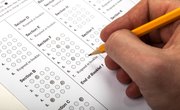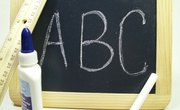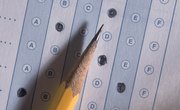Diagnostic tests measure students' understanding of a subject area or skills base. Teachers typically administer diagnostics for reading and math skills, using the results to provide remedial instruction or place students within appropriately leveled classes. Many content teachers, though, give formative assessments to gauge what knowledge students bring to class. Some schools also diagnose concepts as a whole, aiming to reveal commonly held misconceptions in specific subjects.
Reading
Diagnostic tests for reading provide specific information about reading skills. Children take the test individually or in groups; some reading diagnostics are computer based while others require interaction with a test proctor. Such tests are designed to pinpoint at what grade level children are reading based on their mastery of phonics, blending, word recognition and text comprehension. Ideally, a child entering a grade should display reading skills typical of that grade, meaning a fifth grader isn't using sound-out techniques like a first grader. When teachers discover students are reading below grade level, they typically implement interventions designed to bolster the missing skills.
Math
Diagnostic testing in mathematics typically provides a level for the child's mathematical skills -- in this case not just related to grade level but also math topic. Schools often use such diagnostic testing to place students in appropriate math classes, for instance, by determining if they have the prerequisite skills necessary for a higher-level class such as calculus or trigonometry. However, educators use math diagnostics to boost student achievement by encouraging high achievers and offering remedial instruction, including summer school programs, to those who are struggling.
Formative Assessment
The purpose of formative assessments in school is to test students' prior knowledge of a topic. They are not graded like traditional tests. Rather, teachers give formative assessments as a practice or a homework assignment. Results of these diagnostics inform teachers about the direction they need to take in their instruction, meaning how early or advanced in the topic they can begin. Not all formative assessments look like traditional tests. Rather, assessment strategies include student reflections on a topic, charts related to prior knowledge, visual representations of a subject, and even listening in on group discussions.
Conceptual Diagnostic Tests
Discipline-specific conceptual diagnostic tests actually aim to "trick" students, or rather to reveal whether they hold common misconceptions about a subject. Indeed, answer choices on these multiple-choice exams are designed to trigger common misconceptions about the discipline, thus ensuring the student has a clear understanding of the concept. For instance, one question asks when the sun is directly overhead at noon from the students' location; the correct response is "never," not the expected "every day" or "summer solstice," barring students' living near the equator. Not only do conceptual diagnostic tests identify weak areas of key understanding, they aim to neutralize the effect of good test-taking skills -- meaning knowledge of a topic, not test taking, is being assessed.
Related Articles
References
- Scholar Works at Western Michigan University: Evaluation/Testing Procedures in Reading; Elene S. Demos
- Kristina M. Perez: A Review and Critique of the KeyMath Revised – Diagnostic Inventory of Essential Mathematics
- K12: Placement Tests – Math
- Scholastic for Teachers: What Are Formative Assessments and Why Should We Use Them?
Resources
Writer Bio
Nadia Archuleta has a B.A. in English writing. She spent five years working abroad and has traveled extensively. She has worked as an English as a Foreign/Second Language teacher for 12 years.











